NYC Ferry
NYC Ferry is a network of ferry routes in New York City operated by Hornblower Cruises. As of August 2018, there are six routes connecting 21 ferry piers in the Bronx, Brooklyn, Manhattan, and Queens. NYC Ferry has a total of 31 vessels, providing half-hourly to hourly service on each of the routes. As of May 2019, two additional routes and five new piers are planned; the expansion would extend the system to Staten Island, the only New York City borough not served by NYC Ferry.
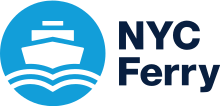 | |
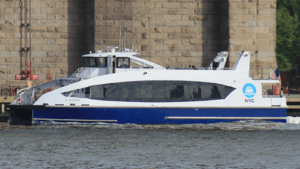 Ferry Lunch Box underway, May 2017. | |
| Locale | New York City |
|---|---|
| Waterway | Atlantic Ocean, East River, Jamaica Bay, Lower and Upper Bays |
| Transit type | Passenger ferry |
| Owner | New York City Economic Development Corporation |
| Operator | Hornblower Cruises |
| Began operation | May 1, 2017 |
| No. of lines |
|
| No. of vessels | 31[1] |
| No. of terminals | 21 (5 planned) |
| Daily ridership | 10,000 (Q1 2019)[2] |
| Website | Official website |
Prior to NYC Ferry, there had been many ferries that traversed the East River and Hudson River, although by the 1960s, almost all ferry services citywide had been discontinued due to the popularity of road and rail transit across the rivers. Ferries in New York City saw a revival in the 1980s and 1990s. As a result of two studies in 2011 and 2013 that showed the effects of these recent ferries, the city officially proposed its own ferry service in 2013, separate from existing New York City ferry systems such as NY Waterway, New York Water Taxi, and the Staten Island Ferry.
NYC Ferry was officially announced by the administration of Mayor Bill de Blasio in 2015, under the tentative name of Citywide Ferry Service. It was planned to launch in two phases. The first phase launched on May 1, 2017, with service along the East River and to the Rockaways. Routes to Bay Ridge and Astoria respectively started in June and August of that year. A second phase, in August 2018, launched to the Lower East Side and Soundview. Ferries to St. George, Staten Island and to Coney Island, are proposed to launch in 2021. Single-ride trips on the system cost $2.75, with monthly and bike fares also available, but there is no free transfer to other modes of transport in the city. NYC Ferry also provides free shuttle buses, connecting to ferry stops in the Rockaways and Midtown Manhattan.
The ferry service was originally expected to transport 4.5 to 4.6 million passengers annually. Higher-than-expected ridership on NYC Ferry routes in summer 2017 caused officials to order new vessels and expand the capacity of existing vessels. In spring 2018, the annual ridership estimates were revised to 9 million, double the original projection, and a further expansion of the NYC Ferry fleet was announced. Despite its crowding, the ferry has generally received positive reviews from passengers. However, there has been criticism over the highly subsidized nature of the service, and NYC Ferry's low ridership compared to the city's other public transit modes.
Background
Early ferries
Until the 19th century, when there were no fixed crossings across the city's waterways, there were many ferries traversing the area.[3] New York's first ferries date to when the city was a Dutch colony named New Amsterdam, which comprises modern-day Lower Manhattan. A ferry across the East River, between New Amsterdam and modern-day Brooklyn, was created in 1642 by Cornelius Dircksen,[4] who was reportedly "the earliest ferryman of whom the records speak."[5] By 1654, New Amsterdam's government passed ordinances to regulate East River ferries.[6] The first ferry to New Jersey was founded in 1661, traveling across the Hudson River from Manhattan to Communipaw (now part of Jersey City).[7] Ferries along the Harlem River, between uptown Manhattan and the Bronx, started in 1667, and a ferry to Staten Island was started in 1712.[8]:38 The number of ferries would grow, and by 1904, there would be 147 ferry services operating in New York City waters.[9]
One of the first documented horse-powered "team" boats in commercial service in the United States was the Fulton Ferry Company, an East River ferry run that Robert Fulton implemented in 1814.[10] The South Ferry Company, founded in 1836, merged with the Fulton Ferry Company three years later, and the combined companies underwent a series of acquisitions, eventually owning many of the East River ferries.[11] However, by 1918, the construction of bridges and New York City Subway tunnels across the East River resulted in some companies, such as the New York and East River Ferry Company between Yorkville and Astoria, operating at a loss.[12] Even with city ownership, many of the East River ferries were superseded by bridges, road tunnels, and subway tunnels by the mid-20th century. The Yorkville–Astoria ferry, for instance, stopped in 1936 after being replaced by the Triborough Bridge.[13]
On the other side of Manhattan, there were a myriad of Hudson River ferries at one point, with boat routes running from New Jersey to twenty passenger docks in Manhattan.[7] However, the construction of the Holland Tunnel, Lincoln Tunnel, Hudson & Manhattan Railroad, and George Washington Bridge between Manhattan and New Jersey, as well as the growth of car ownership in the United States, meant that these ferries were no longer needed by the mid-20th century. As a result, in 1967, the last cross-Hudson ferry (between Hoboken and Battery Park City) ceased operations.[7][9]
The Richmond Turnpike Company started a steamboat service from Manhattan to Staten Island in 1817. Cornelius Vanderbilt bought the company in 1838, and it was sold to the Staten Island Railroad Company in 1864. The Staten Island Ferry was then sold to the Baltimore and Ohio Railroad in 1884, and the City of New York assumed control of the ferry in 1905.[8]:172 The ferry, which still operates, was at one point the only commuter ferry within the entire city, after the discontinuation of the Hoboken ferry in 1967.[7]
Despite the discontinuation of ferry service to New Jersey, people moved to locations along the Hudson River waterfront there. In 1986, waterfront settlements like Bayonne, Highlands, Keyport, Port Liberte, and Weehawken saw a reinstatement of their ferry service to Manhattan, under the operation of NY Waterway.[7] By 1989, around 3,000 of the settlements' combined 10,500 residents paid a $5.00 fare in each direction to board the NY Waterway ferries, despite competition from cheaper alternatives like the PATH train system.[7] Around this time, there were plans to create ferry routes between Inwood and Atlantic City; South Amboy and Wall Street; and from the city proper to New Jersey, Connecticut, and Westchester.[7]
Revival of ferries
In early 2011, the New York City Economic Development Corporation (NYCEDC), and the NYC & Company water travel initiative NYHarborWay, worked with the New York City Department of Transportation (NYCDOT) to release a Comprehensive Citywide Ferry Study, in which it examined over 40 potential locations for a ferry system in New York City.[14]:1 The study was commissioned in order to examine transport alternatives for neighborhoods along New York City's shores.[14]:1, 23–47 It also discussed the East River Ferry, which was set to enter service later that year.[14]:1, 103–111, 130–133, 165 The study identified potential ferry routes to western Manhattan and Riverdale; eastern Manhattan, the South Bronx, and Co-op City; the northern Brooklyn and Queens shorelines; the South Shore of Staten Island; and southwestern Brooklyn, southern Brooklyn, and the Rockaways.[14]:9–14

In June 2011, the NY Waterway-operated East River Ferry line started operations.[15] The route was a 7-stop East River service that runs in a loop between East 34th Street and Hunters Point, making two intermediate stops in Brooklyn and three in Queens. The ferry, an alternative to the New York City Subway, cost $4 per one-way ticket.[15] It was instantly popular, with two to six times the number of passengers that the city predicted would ride the ferries. From June to November 2011, the ferry accommodated 2,862 riders on an average weekday, as opposed to a projection of 1,488 riders, and it had 4,500 riders on an average weekend, six times the city's projected ridership; in total, the ferry saw 350,000 riders in that period, over 250% of the initial ridership forecast of 134,000 riders.[16]
In the aftermath of Hurricane Sandy on October 29, 2012, massive infrastructural damage to the IND Rockaway Line (A train) south of the Howard Beach–JFK Airport station severed all direct subway connections between the Rockaways, Broad Channel, and the Queens mainland for seven months. Ferry operator SeaStreak began running a city-subsidized ferry service between a makeshift ferry slip at Beach 108th Street and Beach Channel Drive in Rockaway Park, Queens, and Pier 11/Wall Street, then continuing on to the East 34th Street Ferry Landing. A stop at Brooklyn Army Terminal was added in August 2013 because of the reconstruction of the Montague Street Tunnel, which temporarily suspended R train service through the tunnel.[17] The ferry proved to be popular and its license was extended several times, as city officials evaluated the ridership numbers to determine whether to establish the service on a permanent basis. Between its inception and December 2013, the service had carried close to 200,000 riders.[18]
The NYCEDC study was updated in 2013, following the introduction of the SeaStreak Rockaway ferry.[19] The study, called "CFS2013", showed the effect of ferry services in New York City, citing the success of the East River ferry. Specifically, ferry service raised the values of real estate within 1 mile (1.6 km) of ferry landings by an average of 1.2%; spurred new construction near ferry stops; added more transport options to neighborhoods with few transit alternatives; and helped relieve crowding on other parts of New York City's transport network.[19]:15–21 The study also suggested extra routes that could be added to the ferry system, with proposed routes that would serve new development in all five boroughs.[19]:22–30 The specific idea of a citywide ferry was also first proposed in the study.[19]:31–69
When the city government announced its budget in late June 2014 for the upcoming fiscal year beginning July 1, the ferry only received a $2 million further appropriation, enough to temporarily extend it again through October.[20] The administration of Mayor Bill de Blasio stated that there was not enough ridership to justify the cost of operation.[21] Despite last-minute efforts by local transportation advocates, civic leaders, and elected officials, ferry service ended on October 31, 2014. They promised to continue efforts to have the service restored.[22][23] This led to many negotiations between the mayor's office and the parties interested in reopening the ferry. The mayor's office eventually agreed to restart the Rockaway ferry when the NYC Ferry system opened.[21]
Proposal
NYC Ferry, first proposed by the NYCEDC as the "Citywide Ferry Service," was announced by de Blasio's administration in 2015 as part of a proposed citywide ferry system that would reach through the five boroughs, though a Staten Island terminal had not been finalized.[3][24] The NYCEDC promised the project, along with the Brooklyn–Queens Connector proposal, as a way to reinvent the city's transit system.[25] Routes were to go to Astoria, Bay Ridge, the Rockaways, the Lower East Side, Soundview, South Brooklyn, and Brooklyn Navy Yard.[26] NY Waterway's East River route was to be transferred to NYC Ferry system as part of the plan.[27] Funding was being sought for a route to Coney Island and Stapleton, but it was not included in NYC Ferry's implementation timeline.[28][29]
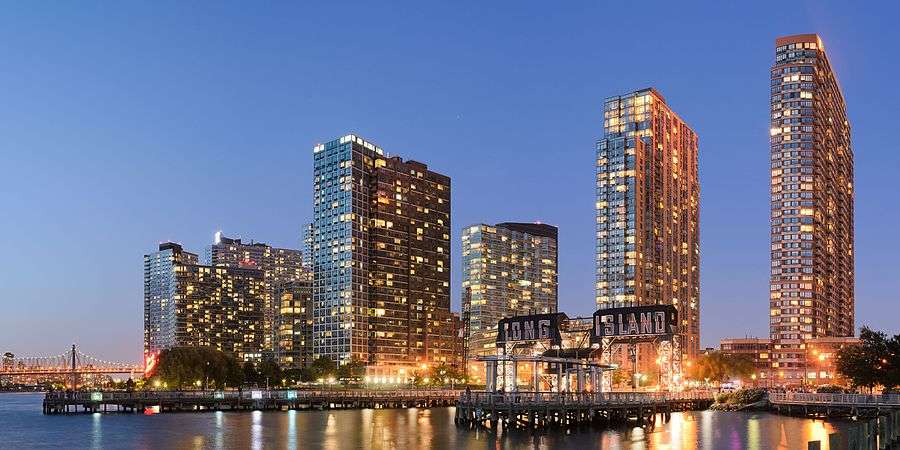
A fare for one trip was set at $2.75, the same as on other modes of transportation in New York City. Free transfers would be offered only to other NYC Ferry lines, meaning that riders would pay another fare if they transferred to one of the city's other mass-transit systems.[30] Transfers to other lines would be issued on request.[31] Prior to the implementation of NYC Ferry, other ferry lines in the city had weekday and weekend fares of $4 and $6, respectively.[32] The relatively low fare of NYC Ferry was made in contrast to some other major cities like San Francisco and Sydney, where ferry fares are higher than the fares of other modes of mass transit in these cities. The city said that the low ferry fares were intended to make the ferries affordable, while de Blasio stated that it is intended to promote "transit equity".[3] Assuming that the ferry system met the projection of 4.5 million annual riders, the city would pay a subsidy of $6.60 per rider, making the ferry the third-most subsidized form of transportation in the city.[33]
NYC Ferry was to cost $325 million[3] with the city contributing an additional operating subsidy of $10 million to $20 million per year.[26] The privately operated ferries[26] were offered under a 6-year contract to Hornblower Cruises, which would receive at least $30 million annually during the course of the contract.[28][34] After having accepted the contract, Hornblower Cruises was selected as the ferry's operator on March 16, 2016.[32][35]
Some of the ferry's six proposed routes were originally supposed to be operational in June 2017,[25] but the implementation date was later moved to May 1.[36] Under the 2015 plan, the whole system is expected to come into full service by 2018.[24] The system includes routes that were formerly under NY Waterway, most notably the East River route.[24] There would be at least 18 boats needed for rush-hour operation.[32] Twelve boats would be deployed in 2017, while the other six would be put in service the next year.[28] The number of boats was later revised slightly to 20, including three boats that would be upgraded later.[37][38]
The creation of the ferry system was supposed to relieve some of the load of the city's transportation system, which is largely "the footprint of an early-19th-century transit map" according to Deputy Mayor Alicia Glen, and cannot accommodate the city's fast population growth.[3] As a result of projected desire for the ferries, annual ridership is expected to eventually reach 4.5 million[3] to 4.6 million.[26] Even though this amounted to only about 12,500 daily riders (compared to the New York City Subway's 5 million riders each weekday), one fellow at the Manhattan Institute said that "every person you’re not cramming on to the trains helps".[32] New York City's deputy mayor for housing and economic development stated, "Our aim is to make this thing as big as possible."[3]
Construction and opening
Planning
NYC Ferry | ||||||||||||||||||||||||||||||||||||||||||||||||||||||||||||||||||||||||||||||||||||||||||||||||||||||||||||||||||||||||||||||||||||||||||||||||||||||||||||||||||||||||||||||||||||||||||||||||||||||||||||||||||||||||||||||||
|---|---|---|---|---|---|---|---|---|---|---|---|---|---|---|---|---|---|---|---|---|---|---|---|---|---|---|---|---|---|---|---|---|---|---|---|---|---|---|---|---|---|---|---|---|---|---|---|---|---|---|---|---|---|---|---|---|---|---|---|---|---|---|---|---|---|---|---|---|---|---|---|---|---|---|---|---|---|---|---|---|---|---|---|---|---|---|---|---|---|---|---|---|---|---|---|---|---|---|---|---|---|---|---|---|---|---|---|---|---|---|---|---|---|---|---|---|---|---|---|---|---|---|---|---|---|---|---|---|---|---|---|---|---|---|---|---|---|---|---|---|---|---|---|---|---|---|---|---|---|---|---|---|---|---|---|---|---|---|---|---|---|---|---|---|---|---|---|---|---|---|---|---|---|---|---|---|---|---|---|---|---|---|---|---|---|---|---|---|---|---|---|---|---|---|---|---|---|---|---|---|---|---|---|---|---|---|---|---|---|---|---|---|---|---|---|---|---|---|---|---|---|---|---|---|
| ||||||||||||||||||||||||||||||||||||||||||||||||||||||||||||||||||||||||||||||||||||||||||||||||||||||||||||||||||||||||||||||||||||||||||||||||||||||||||||||||||||||||||||||||||||||||||||||||||||||||||||||||||||||||||||||||
| ||||||||||||||||||||||||||||||||||||||||||||||||||||||||||||||||||||||||||||||||||||||||||||||||||||||||||||||||||||||||||||||||||||||||||||||||||||||||||||||||||||||||||||||||||||||||||||||||||||||||||||||||||||||||||||||||
In March and April 2015, the city started the process of environmental review for Citywide Ferry.[39]:2 The city requested the draft of the Environmental Impact Statement (EIS) on August 12, 2015, which was completed by April 18, 2016.[40] After public comment, the final EIS was approved on July 28, 2016.[40][41]:2 The project also had a City Environmental Quality Review, which analyzed the ferry's effects on open space, urban design, natural resources, nearby transportation, noise pollution, air quality, the environment, and public health.[39][41]:2
Construction
From January to June 2016, the city bought 4 boats for the proposed ferry service for a combined total of $6 million, with plans for a total of 30 boats over the coming years.[3] Hornblower Cruises requested 13 boats for the first routes, each costing $4 million each.[3][42] The total combined cost of the boats is more than $70 million.[3][43] In addition, the city was building 13 ferry landings at a cost of $85 million, as well as a boat depot.[3] One of these docks, in Astoria, was built privately as part of the Astoria Cove development.[44] In September 2016, construction on 19 ferries began at two shipyards in Bayou La Batre, Alabama, and Jeanerette, Louisiana,[45][42] with 200 full-time employees working on the boats.[46][47] The contract with the two shipyards is unusual because shipbuilding contracts are usually with only one company. However, NYC Ferry executives had purposely chosen these two companies because of their expertise and because of the unlikeliness that both shipyards would be destroyed by hurricanes.[42]
Ferry implementation required permission from several entities. Before the ferry could start service, the NYCDOT was required to approve a new transportation mode within its service area. Additionally, the New York State Department of Environmental Conservation and United States Army Corps of Engineers (CoE) was supposed to give NYC Ferry permission to use of the landings, with the United States Coast Guard advising the CoE's approval of a permit as well as monitoring the design of vessels.[40] In addition, the New York State Office of Parks, Recreation and Historic Preservation had to allow ferries to use the landing at Gantry Plaza State Park, and the Roosevelt Island Operating Corporation was consulted so they could give permission for the Roosevelt Island landing to be built.[40] By September 2016, the Gantry Plaza landing had been approved.[48]
In December 2016, Hornblower purchased the rights to operate the East River route for $21 million. The route had been operated by Billybey Ferries, which had a contract to operate the line under the NY Waterway banner.[49][27] As part of the sale, Hornblower paid $6 million for four older boats already in use on the East River ferry.[49]
The first completed new vessel left the Bayou La Batre facility on around March 24, 2017,[50] and it arrived in New York on April 2, 2017.[51] On April 6, Mayor de Blasio announced that the service had been rebranded from Citywide Ferry to NYC Ferry, and that the start of service had been moved up a month from the original schedule, with the East River, South Brooklyn, and Rockaway routes to begin on May 1,[36] a month ahead of schedule.[52] Under the new schedule, the South Brooklyn route began on June 1[53] and the Astoria route began on August 29,[54][31] while the Lower East Side and Soundview routes are still to begin in 2018.[36][52]
Opening and high ridership

The first two routes were opened on May 1, 2017.[55][56] On its first day of service, NYC Ferry saw more than 6,400 riders; of these, 1,828 rode the Rockaway ferry while the rest rode the East River Ferry.[57] In its first week, the ferry transported 49,000 riders, of which 38,000 used the East River Ferry while the remaining 11,000 used the Rockaway route.[58] Although the service had a 95% on-time rate during the first week, NYC Ferry chartered a boat from NY Waterway due to delays on some routes.[49] NYC Ferry also continued to temporarily use some of the older East River Ferry boats on that route.[49] The ferry grew so popular that during the Memorial Day weekend in May 2017, the routes saw 26,000 passengers over two days, including 9,600 riders on the East River Ferry during each day.[59] Described by The New York Times as the service's "biggest test so far",[59] the 2017 Memorial Day weekend saw reports of hour-long waits for overcrowded ferries.[60]
In June, NYC Ferry had to charter two 400-passenger charter boats for the East Ferry route to alleviate crowding on the routes serving Governors Island[37] while packed boats skipped stops along these routes.[60] By June 22, the ferry had carried 500,000 passengers, a milestone officials had not expected to be reached for several months.[61] Due to unexpected demand, crowding became worse as the summer of 2017 progressed, with packed-to-capacity boats and long waits becoming more common.[62] By July 2017, there were an estimated 83,500 riders on the South Brooklyn route in one month, exceeding the original ridership estimate by more than 30,000.[38] The East River ferry saw about 7,200 riders per average weekday since being taken over by NYC Ferry, up from 3,257 average weekday riders in 2013.[63] That month, three new boats being built were also revised to fit more passengers.[37][38] A 500-passenger boat was also borrowed from SeaStreak for the Rockaway route.[64] By July 26, 2017, NYC Ferry had carried 1 million riders.[65][66]
In August 2017, NYC Ferry filed plans to build four ferry docks: one in Soundview, one in Yorkville, one near Stuyvesant Cove, and one on the Lower East Side.[67][68]:4–5 It also sought to add two more piers to its home port at the Brooklyn Navy Yard.[68]:5 The Soundview route was revised so that it would stop at East 34th Street instead of at East 62nd Street, which would no longer be built.[69] That month, Brooklyn politicians called for docks to be built in Coney Island and Canarsie, owing to the new system's popularity.[70] The Astoria route was projected to carry 1,800 daily passengers upon opening, by which point the service had seen 1.4 million riders.[71] Due to even more ridership demand, three extra ferries were ordered in September 2017, by which time over 2 million people had ridden the ferry.[72] By November 2017, there had been a total of 2.5 million rides on NYC Ferry, compared to the 1.8 million that had been projected by this time, and two of the four routes had already surpassed ridership milestones that the city had not anticipated would be reached until 2019. At that point, the city had spent $16.5 million to subsidize the ferry.[73][74] The New York Post reported in November 2017 that five of the new ferryboats had already been taken out of service due to leaks. According to the Post, the boats were taken out of service starting in October after Coast Guard inspectors observed severe corrosion on the hulls.[75] Hornblower subsequently confirmed the report, saying that the cause of the corrosion was misaligned keel coolers, and that three vessels had been removed from service in October for repair, followed by three more in November.[76]
Construction on the four remaining NYC Ferry docks in Manhattan and the Bronx started on February 28, 2018, in preparation for the start of Lower East Side and Soundview service that summer.[77][78] In May 2018, the first anniversary of the ferry system's opening, de Blasio announced that NYC Ferry had received an extra $300 million to purchase extra boats, increase fleet capacity, and expand service. The number of new boats was not specified, but it was expected that there would be a mix of standard 150-passenger boats and large 350-passenger boats; as a stopgap, Hornblower would charter up to eight 500-passenger boats for temporary use on NYC Ferry. At this point, the city planned that the service would see 9 million riders per year, double the original annual estimate of 4.5 million riders.[79] However, critics stated that the MTA's subway and bus systems carried a combined 7 million passengers per day, and that such a large subsidy for NYC Ferry was disproportionate to the number of people who rode the ferry.[80] According to The Village Voice, NYC Ferry was aiming to transport 24,500 daily riders by 2023, a figure smaller than the 2017 daily ridership of 14 local bus routes. NYC Ferry had averaged 10,000 daily riders in 2017, while the bus and subway system had respectively carried 2 million and 5 million daily riders on average.[81]
In August 2018, it was announced that service on NYC Ferry's Soundview and Lower East Side routes would begin that month.[82] The route to Soundview opened on August 15, 2018,[83][84] followed by the Lower East Side route on August 29.[85][86] New York City Transit extended select Bx27 bus trips to Clason Point Park to serve the Soundview route in summer 2018.[87]
Further expansion
Following the opening of the Lower East Side route in August 2018, de Blasio stated that he planned for the system to expand further.[88] In January 2019, de Blasio announced further expansions to the NYC Ferry system to take place by 2021. There would be two new routes to Staten Island and Coney Island, as well as extensions of two additional routes. The Staten Island route would travel between Manhattan's West Side and the St. George Terminal in St. George, Staten Island, and was originally slated to open in 2020, but was pushed back to 2021. The Coney Island route would travel between Pier 11 Wall Street and Coney Island, and would start operating in 2021. The Astoria route would make an extra stop at Brooklyn Navy Yard, while the Soundview route would be extended from Soundview east to Throggs Neck. The South Brooklyn route would terminate at Brooklyn Army Terminal, and the existing Bay Ridge ferry pier would be served by the Coney Island route.[89][90] The Brooklyn Navy Yard stop opened on May 20, 2019.[91][92] The same month, NYC Ferry launched a new weekend-only shuttle from Pier 11/Wall Street to Governors Island, replacing the East River and South Brooklyn service to the island.[93]
The service expansion required that the city increase its per-rider subsidy to $8.[94] In March 2019, the nonprofit Citizens Budget Commission (CBC) found that NYC Ferry was one of the most subsidized forms of transport in New York City, despite having low ridership. The CBC found that the city paid $10.73 per person per ride, and once the Coney Island route started operating, the subsidy to NYC Ferry would rise to $25 per person per ride. The per-ride subsidy was so high because NYC Ferry had only 4.1 million passengers in 2018, less than the total subway patronage on an average weekday. Furthermore, NYC Ferry ridership tended to decline by two-thirds between August and January of each year.[95][96] In January 2020, the NYCEDC announced three minor changes to the expansion plan. The St. George ferry's Staten Island terminal would be Empire Outlets rather than St. George Terminal; the South Brooklyn route would be truncated to a new stop at Industry City; and the Coney Island ferry would go directly between Bay Ridge and Wall Street without a stop at the Brooklyn Army Terminal.[97]
With the COVID-19 pandemic in New York City in March 2020, the regular Spring 2020 schedule was cancelled and remained on the Winter 2020 schedule with reduced service during mid-days and weekends. On May 15, 2020, it was announced that service was further reduced, all ferry service ending at 9 p.m., with the discontinuation of the Lower East Side route, the addition of the Stuyvesant Cove stop to the Soundview line, and the modification of the South Brooklyn route to run from Atlantic Avenue to Wall Street, Dumbo, and to its new last stop at Corlears Hook. This service change started on May 18, 2020.[98][99] The ferry to Staten Island would not be implemented until 2021, along with the Coney Island and Throggs Neck expansions.[100][101] On June 27, 2020, the summer schedule was implemented, increasing frequency of all routes in response to high summer ridership, except for the Governors Island route, which remained indefinitely suspended until July 18 when a new summer schedule was created.[102][103] Shortly after, de Blasio budgeted $62 million for eight new vessels, despite citywide budget cuts caused by the pandemic.[104]
Rider reception
According to an August 2017 customer satisfaction survey from the NYCEDC, passengers had a mostly positive view of the NYC Ferry system, with 93% of riders giving positive ratings.[105][81] Almost 70% of the 1,300 riders surveyed gave the ferry the highest possible rating.[106] In May 2018, The Village Voice conducted an informal demographic survey of NYC Ferry riders, since the NYCEDC had not officially released the rider-demographic data. The Voice found that most of the 60 riders it encountered were using the ferry simply because it was less crowded and more comfortable compared to the subway. Additionally, many of the surveyed riders worked in higher-income jobs.[81]
Routes
There are currently five routes and one seasonal route that make up the NYC Ferry system.[107][108] There was a phased introduction of these routes. Phase 1 covered the routes implemented in 2017 and provided new service to the Rockaways, Bay Ridge, Sunset Park, Roosevelt Island, and Astoria in addition to areas already served by the East River Ferry. Phase 2 covered the routes implemented in 2018 and provided new service to Soundview, Yorkville, Kips Bay, and the Lower East Side.[25][34][43][40] In 2019, the summer weekend extension of the East River and South Brooklyn lines to Governor's Island was eliminated, and replaced by a new Governors Island shuttle route. The Governor's Island route is seasonal and only operates during summer weekends, and was launched in the summer of 2019. Two additional routes, to Coney Island, Brooklyn, and to St. George, Staten Island, are expected to start operating in 2021.[89][90] There are two main Manhattan terminals at Wall Street and East 34th Street.[41]:5
On May 18, 2020, in response to the ongoing COVID-19 pandemic in New York City, the Lower East Side route was discontinued, the South Brooklyn was extended to end at Corlears Hook, and Stuyvesant Cove was added as a stop to the Soundview route between the 34th Street and Wall Street stops.[98]
| Start date | Route[108] | Terminals[41]:6[89][90][108] | Intermediate stops[41]:6[89][90][108] | Notes[108] | ||
|---|---|---|---|---|---|---|
| North | ↔ | South | ||||
| Preexisting service |
East River Ferry[109] | East 34th Street | ↔ | Pier 11/Wall Street |
|
|
| 2017 | Rockaway Ferry[110] | Pier 11/Wall Street | ↔ | Rockaway (Beach 108th Street) | ||
| South Brooklyn Ferry[111] | Corlear's Hook (Lower East Side) | ↔ | Bay Ridge |
|
| |
| Astoria Ferry[112] | Astoria | ↔ | Pier 11/Wall Street |
|
| |
| 2018 | Soundview Ferry[113] | Soundview | ↔ | Pier 11/Wall Street |
|
|
| 2019 | Governors Island Ferry[114] | Pier 11/Wall Street | ↔ | Governors Island | No intermediate stops | * Seasonal weekend service only |
| starting 2021 | St. George Ferry[115] | West Midtown/Pier 79 at Hudson River Park | ↔ | Empire Outlets |
| |
| Coney Island Ferry[116] | Coney Island | ↔ | Pier 11/Wall Street |
|
||
These routes have been discontinued.
| Start date | End date | Route[108] | Terminals[41]:6[89][90][108] | Intermediate stops[41]:6[89][90][108] | ||
|---|---|---|---|---|---|---|
| North | ↔ | South | ||||
| 2018 | 2020 | Lower East Side Ferry[117] | Long Island City | ↔ | Pier 11/Wall Street |
|
In addition to ferry service, NYC Ferry also operates 3 shuttle buses to connect passengers with ferry landings.
| Start date | Route[108] | Terminals[41]:6[89][90][108] | Notes | ||
|---|---|---|---|---|---|
| North | ↔ | South | |||
| 2017 | East River Midtown Shuttle[117] | Midtown Manhattan-48th St | ↔ | East 34th Street Ferry Terminal |
|
| 2017 | Rockaway West Shuttle[117] | Rockaway Point Blvd/Beach 169th St | ↔ | Beach Channel Drive/Beach 108th St
(Ferry Terminal) |
|
| 2017 | Rockaway East Shuttle[117] | Beach Channel Drive/Beach 108th St
(Ferry Terminal) |
↔ | Beach Channel Drive/Beach 35th St |
|
Astoria Ferry
Astoria ferries run in both directions with year-round service running every 25 minutes during rush hours, every 50 minutes during weekday middays and evenings, and every 1 hour and 40 minutes during weekends.[112][36]
The route began stopping at the Brooklyn Navy Yard/Pier 72 in May 2019.[89][90][118]
| Stop | Transfers[112][119][120][121] |
|---|---|
| Astoria 3-10 Astoria Boulevard, Queens 40.772114°N 73.937178°W |
Q18, Q19, Q102 and Q103 buses |
| Roosevelt Island South Under the Queensboro Bridge, East Channel 40.755198°N 73.953020°W |
Roosevelt Island Tramway F and <F> trains at Roosevelt Island Q102 bus |
| Long Island City North 47th Road, Gantry Plaza State Park, Queens 40.747706°N 73.959394°W |
7 and <7> trains at Vernon Boulevard–Jackson Avenue Q102 and Q103 buses |
| East 34th Street Ferry Landing FDR Drive/34th Street, Manhattan 40.74388°N 73.97393°W |
SeaStreak M34 SBS, M34A SBS and M15 buses |
| Brooklyn Navy Yard Dock 72, near 63 Flushing Avenue 40.702°N 73.969°W |
B57 and B67 buses |
| Pier 11 at Wall Street South Street at Gouverneur Lane 40.70376°N 74.00919°W |
SeaStreak New York Beach Ferry M15, M15 SBS, BM1, BM2, BM3, BM4, QM7, QM8, QM11, QM25, SIM5, SIM15 and SIM35 buses |
East River Ferry
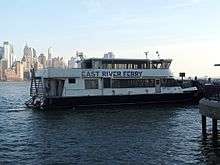
East River ferries operate in both directions with year-round service, running every 20 minutes during rush hours, every 40 minutes during middays and evenings, and every 1 hour on weekends.[109]
| Stop | Transfers[109][119][120][121] |
|---|---|
| East 34th Street Ferry Landing FDR Drive/34th Street, Manhattan 40.74388°N 73.97393°W |
NY Waterway shuttle bus SeaStreak M34 SBS, M34A SBS and M15 buses |
| Hunters Point South Center Boulevard & Borden Avenue, Queens 40.74159°N 73.96195°W |
7 and <7> trains at Vernon Boulevard–Jackson Avenue Long Island City LIRR station Q103 bus |
| Greenpoint India Street, Brooklyn 40.73183°N 73.96196°W |
G train at Greenpoint Avenue B24, B32, B43 and B62 buses |
| North Williamsburg North Sixth Street, Brooklyn 40.71977°N 73.9645°W |
L train at Bedford Avenue B32, B62 and Q59 buses |
| South Williamsburg Schaefer Landing, Brooklyn 40.70922°N 73.97144°W |
B32, B62 and Q59 buses |
| Dumbo/Fulton Ferry Fulton Street, Brooklyn 40.70367°N 73.99806°W |
New York Water Taxi A and C trains at High Street F and <F> trains at York Street B25 bus |
| Pier 11 at Wall Street South Street, Manhattan 40.70376°N 74.00919°W |
SeaStreak New York Beach Ferry M15, QM7, QM8, SIM5, SIM5X, SIM15 and SIM35 buses |
Rockaway Ferry
The Rockaway Ferry route runs in both directions with year-round service. Service operates every 60 minutes during weekdays and every 1 hour and 30 minutes during weekends.
In May 2018, a special Rockaway Express service was implemented, running express between Wall St/Pier 11 and Rockaway, skipping Sunset Park. However, this service did not return for the summer 2019 season.[110]
| Stop | Transfers[110][122][119][120] |
|---|---|
| Pier 11 at Wall Street South Street at Gouverneur Lane 40.70376°N 74.00919°W |
SeaStreak New York Beach Ferry M15, QM7, QM8, SIM5, SIM5X, SIM15 and SIM35 buses |
| Sunset Park Brooklyn Army Terminal, Brooklyn 40.6455°N 74.02608°W |
N, R, and W trains at 59th Street B11 and B37 buses |
| Rockaway Beach 108th Street, Queens 40.58188°N 73.83285°W |
Rockaway shuttle buses A and S trains at Beach 105th Street Q22 bus |
South Brooklyn Ferry
South Brooklyn ferries run in both directions with year-round service running every 30 minutes during rush hours, every 60 minutes middays and evenings, and every 1 hour and 30 minutes on weekends.[111]
Service to Dumbo, the Brooklyn Army Terminal, and Bay Ridge will be discontinued in 2021, though Bay Ridge will be served by a new Coney Island route.[89][90][118] Additionally, a new stop at Industry City will open in 2021 and will be the route's southern terminus, although since the routes modification in May 2020, it is unclear if these future service changes will be implemented.[97]
In May 2020, this route was modified to replace the Lower East Side route when it was discontinued. The route north of Atlantic Av was changed, where it now serves Wall St before DUMBO, and was extended to now end at Corlear's Hook.
| Stop | Transfers[111][122][119][120][121] |
|---|---|
| Corlear's Hook FDR Drive at Grand Street 40.71042°N 73.97919°W |
M14A bus |
| Dumbo/Fulton Ferry Fulton Street, Brooklyn 40.70367°N 73.99806°W |
New York Water Taxi A and C trains at High Street F and <F> trains at York Street B25 bus |
| Pier 11 at Wall Street South Street at Gouverneur Lane 40.70376°N 74.00919°W |
SeaStreak New York Beach Ferry M15, QM7, QM8, SIM5, SIM5X, SIM15 and SIM35 buses |
| Brooklyn Bridge Park Pier 6 Atlantic Avenue, Brooklyn 40.69197°N 74.00308°W |
B57, B61 and B63 buses |
| Red Hook Brooklyn 40.67819°N 74.02006°W |
B61 bus |
| Sunset Park Brooklyn Army Terminal, Brooklyn 40.6455°N 74.02608°W |
N, R, and W trains at 59th Street B11 and B37 buses |
| Bay Ridge Bay Ridge Avenue, Brooklyn 40.63932°N 74.03988°W |
B9 and B64 buses |
Soundview Ferry
Soundview ferries run in both directions. Service on this route runs every 30–35 minutes during rush hours, every 60 minutes during middays and evenings, and every hour and 40 minutes on weekends.[113]
The route will be extended from Soundview to Throggs Neck in 2021.[89][90][118]
This route was modified to replace LES service in the Lower East Side.
| Stop | Transfers[113][120][123][121] |
|---|---|
| Soundview and Clason Point 2 Bronx River Parkway 40.80479°N 73.84864°W |
6 train at Morrison Avenue–Soundview Bx27 and Bx39 buses |
| Yorkville 90th Street 40.77726°N 73.94217°W |
N, Q, and R trains at 96th Street M31 and M86 buses |
| East 34th Street Ferry Landing FDR Drive/34th Street, Manhattan 40.74388°N 73.97393°W |
NY Waterway shuttle bus SeaStreak M34 SBS, M34A SBS and M15 buses |
| Stuyvesant Town Stuyvesant Cove Park, 20th Street at Avenue C/FDR Drive 40.73193°N 73.97321°W |
M9, M23 SBS and M34A SBS buses |
| Pier 11 at Wall Street South Street at Gouverneur Lane 40.70376°N 74.00919°W |
SeaStreak New York Beach Ferry M15, QM7, QM8, SIM5, SIM5X, SIM15 and SIM35 buses |
Governors Island Ferry
A shuttle from Pier 11/Wall Street to Governors Island runs every 30 minutes on summer weekends only.[114]
| Stop | Transfers[120] |
|---|---|
| Pier 11 at Wall Street South Street at Gouverneur Lane 40.70376°N 74.00919°W |
SeaStreak New York Beach Ferry M15, QM7, QM8, SIM5, SIM5X, SIM15 and SIM35 buses |
| Governors Island (summer weekends only) 40.69107°N 74.012236°W |
St. George Ferry
Service on this route will begin in 2021. It will be the first NYC Ferry route to not stop at Wall St/Pier 11.[115][89][90][118]
| Stop | Transfers[120][124] |
|---|---|
| West Midtown/Pier 79 at Hudson River Park Hudson River Park, 39th Street at 12th Avenue, Manhattan 40.76043°N 74.00349°W |
NY Waterway M12, M42 and M50 buses |
| Battery Park City Ferry Terminal Vesey Street, Manhattan 40.71517°N 74.01739°W |
NY Waterway Liberty Water Taxi M9 and M20 buses |
| Empire Outlets 1 Bay Street, Staten Island 40.64515°N 74.07470°W |
Staten Island Ferry at St. George Terminal Staten Island Railway at St. George Terminal S40, S42, S44, S46, S48, S51, S52, S61, S62, S66, S74, S76, S78, S81, S84, S86, S90, S91, S92, S94, S96 and S98 buses |
Coney Island Ferry
Service on this route will begin in 2021.[116][89][90][118]
| Stop | Transfers[119][122] |
|---|---|
| Pier 11 at Wall Street South Street at Gouverneur Lane 40.70376°N 74.00919°W |
SeaStreak New York Beach Ferry M15, QM7, QM8, SIM5, SIM5X, SIM15 and SIM35 buses |
| Bay Ridge Bay Ridge Avenue, Brooklyn 40.63932°N 74.03988°W |
B9 and B64 buses |
| Coney Island Final location to be determined |
Discontinued routes
Lower East Side Ferry
The Lower East Side route originally ran in both directions, with service on this route running every 25 minutes during rush hours, every 60 minutes during middays and evenings, and every hour and 30 minutes during off-peak hours.[117] This route was permanently discontinued on May 18, 2020, due to low ridership, and was replaced by the Astoria, Soundview, and South Brooklyn lines.[98]
| Stop | Transfers[117][120][119][121] |
|---|---|
| Long Island City North 47th Road, Gantry Plaza State Park, Queens 40.747706°N 73.959394°W |
7 and <7> trains at Vernon Boulevard–Jackson Avenue Q102 and Q103 buses |
| East 34th Street Ferry Landing FDR Drive/34th Street, Manhattan 40.74388°N 73.97393°W |
SeaStreak M34 SBS, M34A SBS and M15 buses |
| Stuyvesant Town Stuyvesant Cove Park, 20th Street at Avenue C/FDR Drive 40.73193°N 73.97321°W |
M9, M23 SBS and M34A SBS buses |
| Corlear's Hook FDR Drive at Grand Street 40.71042°N 73.97919°W |
M14A bus |
| Pier 11 at Wall Street South Street at Gouverneur Lane 40.70376°N 74.00919°W |
SeaStreak New York Beach Ferry M15, QM7, QM8, SIM5, SIM5X, SIM15 and SIM35 buses |
Fares and amenities
The fare for a single, one-way trip is $2.75,[125][126] the same as on other modes of transportation in New York City such as the subway.[30][56] Bicyclists must pay an additional $1 to board their bikes on ferries.[125][30][126] Riders can transfer to other ferry routes within the system for free[32] for ninety minutes after the passenger boards the first ferry.[30] though this excludes the fare-free Staten Island Ferry, since it will not be integrated into NYC Ferry.[24] In addition, the NYC Ferry system does not provide free transfer to the Metropolitan Transportation Authority's greater mass transit system,[3][34][127] nor does it accept MetroCards.[127] Ferry tickets can be purchased online, through NYC Ferry's mobile app, or physically at a ticket booth or ticket machine.[125] A 30-day pass costs $121, while a 30-day pass for bikers costs $141.[30][125]
The 85-foot (26 m) boats can carry 150 people each, including wheelchairs, strollers, and bikes.[46] As a further incentive, the boats have snacks and drink options, including coffee and wine, that are available to riders.[34][28][59] There are also battery-charging stations on board the boats.[56][59][128]
Stops

The service would ultimately have 21 landings, of which ten would be brand-new, five would be upgraded, and six would be preexisting landings that would not be changed with the addition of NYC Ferry routes.[41]:6 The existing East River Ferry landings at Brooklyn Bridge Park Pier 1; Schaefer Landing; North Williamsburg; Greenpoint; and Long Island City remained unchanged. There would be upgrades to the landings at Wall Street; East 34th Street; East 92nd Street; Brooklyn Army Terminal; and Brooklyn Bridge Park Pier 6. The remaining landings were built as part of the project.[41]:6 A stop on Governor's Island was implemented along one of the routes to South Brooklyn. At the time, Governor's Island Ferry, the only public access to the island, runs seasonally between May and September, but the proposed Governor's Island stop would feature ferry service year-round.[41]:6[129] It was decided to build the Rockaway dock at Beach 108th Street, but a second dock could not be built further east than Beach 84th Street due to height restrictions caused by the Rockaway Line subway bridge.[28] Construction on the first dock, the Rockaway landing, began in January 2017.[130][131]
The upgraded landings, which increase capacity and passenger flow, are located on 35-by-90-foot (11 by 27 m) barges that connect to land via the use of either one or two articulated ramps. The landings conform to the Americans with Disabilities Act and contain enclosed waiting rooms with ticket booths and information boards.[41]:7 Mono-pile mooring facilities are installed on the side of the landings to ensure that the ferries dock safely, but some landings also include extra bulkheads or piers.[41]:7
Ferry fleet
In July 2016, Metal Shark Boats and Horizon Shipbuilding were jointly awarded construction contracts for the service's new build ferries.[132] The vessels, which were designed by Incat Crowther, are about 85 feet (26 m) long, with a 26 feet (7.9 m) beam, and have a passenger capacity of 149.[132] They are powered by Baudouin diesel engines, with a service speed of 25 knots (29 mph).[132] By September, nineteen ferries were being built for Phase 1 of service.[46][45][47] In January 2017, five more ferries were ordered from Horizon Shipbuilding, for a total of 24 vessels.[133] The first new build vessel for NYC Ferry was launched by Horizon Shipbuilding on February 13.[134] These boats arrived in New York City on April 17 and were named at a ceremony at Brooklyn Bridge Park.[135]
The boats use the same types of loading equipment on the port, starboard, and bow as do boats that already operated in the New York Harbor.[41]:7 There are two types of boats: an open-water "Rockaway vessel" type for the Rockaway route, and another "river vessel" type for the rest of the system. Both designs have a common 86 feet (26 m) length and 26.25 feet (8.00 m) beam, but the Rockaway service vessels have a slightly deeper draft and higher freeboard, as well as added fuel capacity and larger engines giving a slightly higher service speed.[134] All of the vessels are powered by engines that pass Environmental Protection Agency Tier 3 Vehicle Emission and Fuel Standards guidelines.[41]:7 Ferry horns' volumes were lowered in June 2017 after complaints by residents living near ferry stops.[136]
The Brooklyn Army Terminal and Brooklyn Navy Yard were considered for the location of the vessel maintenance facility.[39]:4[41]:7 The Navy Yard option, which the city preferred because of its proximity to the "core operating area" of the routes and would allow an extra station to be added there in the future,[39]:4[41]:7 was eventually selected. Renovation of the site was required to remove an existing pier and replace it with a new structure capable of docking up to 25 boats. This new facility would be responsible for performing regular cleaning and maintenance on the vessels. The construction work began in spring 2017 with completion in March 2019.
Originally three of the twenty 149-passenger vessels were to be reconfigured into 250-passenger boats. The plan was scrapped as the city will be ordering additional 250 or 350 passenger vessels. In September 2017, the NYCEDC ordered three new 350-passenger boats for NYC Ferry service to supplement the 20 original boats. Metal Shark would build the new boats for $7 million to $7.5 million each.[72] Three more large boats were ordered in November 2017.[73] Additional large boats (250-350 passenger) are expected to be ordered within 2019–2020. As part of the contract between the city and Hornblower, both parties have options for the city to buy the boats in the future.[73] The first of the new 350-passenger boats was delivered in July 2018.[138][139]
By early 2020, a total of 31 vessels were in active service. In April, the first two vessels powered by engines meeting EPA Tier 4 emissions standards were delivered, with five additional ferries under construction and scheduled to enter service by the end of the year. By this time, the construction program had expanded beyond Metal Shark to include other shipbuilders in both Louisiana and Florida.[1]
Before being allowed to pilot a NYC Ferry vessel, prospective captains are tested using a ferry simulation at the State University of New York Maritime College in Throggs Neck. As of April 2017, there were plans to hire up to 50 captains by 2018.[140][141] In July 2017, Hornblower started looking to hire 80 deckhands to dock boats.[142]
Active roster
The following vessels are owned and operated by Hornblower for NYC Ferry operation, and do not include vessels leased from other companies.
| Image | Vessel Name (Vessel Number) | Year | Primary Vessel Lines Served | Notes |
|---|---|---|---|---|
 |
Waves of Wonder (HB-101) | 2016 |
|
|
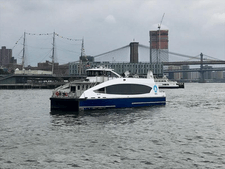 |
Sunset Crossing (HB-102) | |||
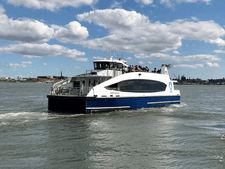 |
Happy Hauler (HB-103) | |||
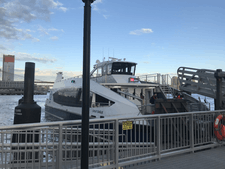 |
Great Eagle (HB-104) | |||
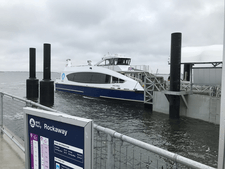 |
Owl's Head (HB-105) | |||
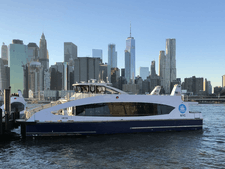 |
Munsee (HB-106) | |||
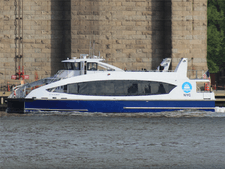 |
Lunchbox (H-200) | |||
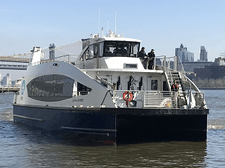 |
Urban Journey (H-201) | |||
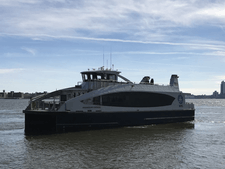 |
Friendship Express (H-202) | |||
 |
Connector (H-203) | 2016-2017 |
|
|
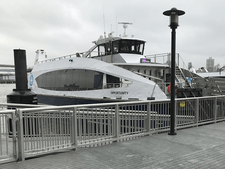 |
Opportunity (H-204) | |||
 |
Flyer (H-205) | |||
 |
McShiny (H-206) | 2017-2018 |
|
|
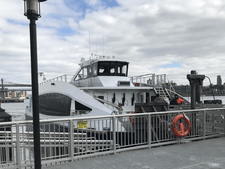 |
Starlight (H-207) | |||
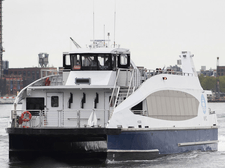 |
Spring Mallard (H-208) | |||
 |
Atlantic Compass (H-209) | |||
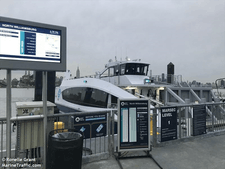 |
HB-107 | |||
 |
Ocean Queen Rockstar (HB-108) | 2018-2019 |
|
|
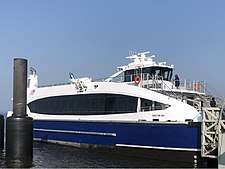 |
Seas the Day (HB-109) | |||
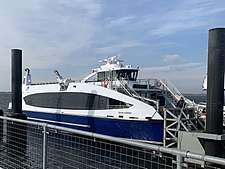 |
Golden Narrows (HB-110) | |||
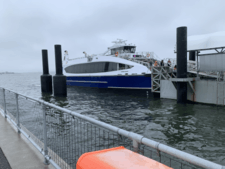 |
Rainbow Cruise (HB-111) | |||
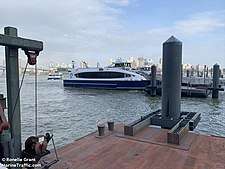 |
Unity (HB-112) | |||
 |
Traversity (HB-113) | |||
 |
Jewel of the Harbor (HB-114) | |||
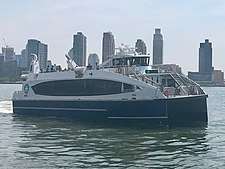 |
H-214 | |||
 |
HB-115 | |||
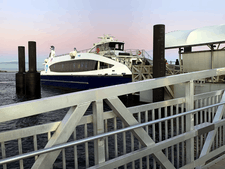 |
H-90 | |||
 |
H-215 | |||
| HB-119 | 2019-2020 |
|
| |
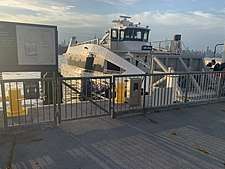 |
HB-120 | |||
 |
Cyclone Shark (HB-121) | |||
| H-501 | ||||
| Tooth Ferry (HB-122) | ||||
| H-91 | 2020 |
|
| |
| H-401 | ||||
| Curiosity (H-301) | ||||
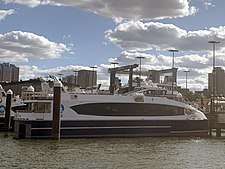 |
City Fishy (H-92) |
Schedules and shuttle buses
NYC Ferry operates from 5:30 a.m. to 10:30 p.m. during all seven days of the week.[40][41]:9 During peak hours, ferries operate or are proposed to operate at 20-minute headways to Astoria and the Lower East Side; 30-minute headways to Bay Ridge and Soundview; and 30-60 minute headways to the Rockaways (see § Routes for more details).[41]:9
NYC Ferry operates three shuttle bus routes. One was taken over preexisting NY Waterway service to the East 34th Street landing.[41]:9 The others are brand-new services to the Rockaway landing, which is at Beach 108th Street.[28] One route goes west to Jacob Riis Park,[40][41]:9 while a second was originally planned for operation between the ferry landing and Beach 67th Street, but was ultimately extended eastward.[28] The Environmental Impact Statement provided for an extension of the Beach 67th Street bus to Beach 31st Street via Rockaway Beach Boulevard and Beach Channel Drive,[40][41]:9 but de Blasio's office said that extending the bus further would cause a bus fleet shortage, resulting in passengers missing their boats.[28] In May 2019, as part of a three-month pilot program, a nonstop shuttle bus route was created between the Rockaway landing and Far Rockaway–Mott Avenue station.[143]
Critical reception

There has been both praise and criticism for the ferry service.[144][145] The editorial board in the local newspaper AM New York praised the NYC Ferry system's affordability and stated that if done correctly, the ferry "could be far more enjoyable than a subway ride".[144] It urged city officials to consider what routes to prioritize for Phase 1 service in 2017.[144] Politicians such as City Councilman Vincent Gentile and State Senator Marty Golden also lauded the fact that the ferry would bring service to places, such as southwest Brooklyn, that are underserved by transportation.[146]
In July 2017, after the ferry had opened, a commentator for the news website CityLab called the NYC Ferry system's "customer-oriented amenities" a "key to transit’s future." The writer noted that some of the high-quality amenities included snacks and drinks, an advanced ticketing system, connections to shuttle buses at certain terminals, and ferry workers who provided customer service—in contrast to the Metropolitan Transportation Authority, which she said "blames riders for its staggering decline in reliability" over the previous year.[147] A reporter for Curbed NY wrote in September 2017 that the East River route was "worth the $2.75 fare, especially if you’re a person who loves architecture", owing to its waterfront views of landmarks along the river.[148]
The ferry system has been criticized for mainly benefiting the well-off and for serving gentrifying waterfront areas such as Williamsburg.[149] Most of the ferry stops were placed in areas where the annual income is higher than the city average.[150] Additional criticism arose from the fact that the ferry system was not definitively planned to serve Staten Island. One writer for the Staten Island Advance noted that the only proposed NYC Ferry route to Staten Island, the Stapleton route, was not only unfunded but also redundant to the existing Staten Island Ferry.[151]
After NYCEDC president James Patchett touted the ferry as a substitute to the subway system, Henry Grabar of Slate's Moneybox noted that Patchett's supposition was "ludicrous" since each ferry fits fewer people than a single subway car. According to Grabar, the first half-dozen ferries in service on opening day did not even carry the same number of people in a single subway train. He said that the ferry system was not a way to improve transit access to people in transit-deserts, but as a way to spur economic development along the waterfront.[152] Grabar wrote that subways had been the reason for early ferries' demise in the first place, and that the ferry was not an effective remedy for subway congestion. However, Grabar also stated that "the commute will be a real delight" for the few who found the ferry convenient enough.[152] Benjamin Kabak, a transit blogger, wrote that "the reach of the ferries is particularly narrow", out of walking distance for 94% of city residents. He also noted that the total ridership for NYC Ferry in 2017 was less than the New York City Subway's total daily ridership, and that more than three times as many people rode Citi Bike, the city's bike-share system, than took the ferry in 2017. Kabak stated that the ferry system was only a small part of the city's transit future, and that the city could easily build a light rail line with the subsidies that it was paying to fund NYC Ferry.[153] The New York Post editorial board wrote in June 2020, "Mayor Bill de Blasio’s favorite white elephant had turned into a real drag on the city" even before the COVID-19 pandemic, with the NYCEDC recording its first negative profits in 2019.[154]
Tom Fox, the president of New York Water Taxi from 2001 to 2011, wrote in 2016 that the plan was marred with "an unrealistic time frame, the wrong lead agency, the selection of an inexperienced operator with no ferries, and poor planning".[145] Fox cited the selection of Hornblower Cruises, a California-based cruise operator, despite a bid from three large ferry operators in the New York metropolitan area; the decision to build new boats for the system, instead of buying existing boats from other companies; and the fact that the new boats could accommodate fewer people than the overcrowded existing East River ferries.[145] He noted that the city bought French motorboat engines that had never been used on passenger boats in the United States; and that since all American shipyards with expertise were not able to take new orders until 2018, the city decided to use a builder with less experience.[145] Additionally, a reporter for DNAinfo.com wrote that Hornblower Cruises had a history of poor relations with its workers' unions.[155] Another writer for that website stated that Hornblower had hired ticket sellers who harangued passersby in order to sell tickets for separate ferries in Lower Manhattan.[156] The aggressive ticket-selling practice was stopped following the latter story.[157]
Other ferries
Several ferries in the New York City area were affected when plans for NYC Ferry were made public. NY Waterway would give over its East River route to NYC Ferry.[24] New York Water Taxi remained separate, but was to eliminate 200 jobs;[24] it had stated that if it did not win the contract with the city to operate NYC Ferry, then it would shut down.[32] Since the company did not win the NYC Ferry contract, it had been expected to shut down in October 2016,[158] but continued operations through the end of the year before being purchased by Circle Line Sightseeing Cruises in January 2017.[159] The city-owned Staten Island Ferry remains a separate entity.[24] In addition, the ferry service would add 155 jobs to the New York Harbor area.[24]
Due to the lack of concrete plans for any NYC Ferry routes to Staten Island, there have been tentative agreements with other ferry services to provide fast-ferry service between Staten Island and Manhattan, supplementing the city-owned route there. In April 2017, Staten Island Borough President James Oddo negotiated with NY Waterway to provide service between St. George Terminal and West Midtown Ferry Terminal.[160][161] In September of the same year, private developers on the South Shore of Staten Island also negotiated with SeaStreak to run a separate fast ferry route from the South Shore to Lower Manhattan.[162]
References
- "NYC Ferry takes delivery of first Tier 4 compliant vessels". Marine Log. April 17, 2020. Retrieved April 18, 2020.
- "2019 Q1 Quarterly Update" (PDF). NYC Ferry. 2019. Retrieved July 4, 2019.
- Mcgeehan, Patrick (June 15, 2016). "De Blasio's $325 Million Ferry Push: Rides to 5 Boroughs, at Subway Price". The New York Times. ISSN 0362-4331. Retrieved June 28, 2016.
- Booth, Mary Louise (1859). History of the city of New York: from its earliest settlement to the present time. W.R.C. Clark & Meeker. p. 684. Retrieved September 18, 2017 – via Internet Archive.
- Valentine, D.T. (1853). "History of the City of New York". J.P. Putnam & Company. p. 31. Retrieved September 18, 2017 – via Internet Archive.
- Millstein, Barbara (1983). The Great East River Bridge, 1883-1983. Brooklyn Museum. pp. 140–141. ISBN 978-0-87273-096-0. Retrieved September 18, 2017.
- Eftimiades, Maria (December 24, 1989). "Ferryboats Again Becoming a Familiar Sight Along Hudson". The New York Times. Retrieved September 23, 2016.
- Adams, Arthur G. (1983). The Hudson through the years. Lind Publications. Retrieved September 18, 2017.
- Martin, Douglas (September 10, 1993). "3 Companies Are Picked For Ferries". The New York Times. ISSN 0362-4331. Retrieved September 22, 2017.
- Roberts, Sam (December 28, 2014). "How a Ferry Ride Helped Make Brooklyn the Original Suburb". The New York Times. Retrieved September 18, 2017.
- "THE EAST RIVER FERRIES; HISTORY OF THE UNION FERRY COMPANY". The New York Times. February 29, 1880. ISSN 0362-4331. Retrieved September 18, 2017.
- "CITY MAY TAKE OVER FERRY.; New Subways Hit Boats from 92d Street to Long Island". The New York Times. June 2, 1918. ISSN 0362-4331. Retrieved September 23, 2016.
- "CITY TO STOP FERRY TO ASTORIA AT ONCE; Sinking Fund Commission Is Expected to Act Wednesday on Abandoning Line". The New York Times. July 25, 1936. ISSN 0362-4331. Retrieved September 23, 2016.
- "Comprehensive Citywide Ferry Study 2011" (PDF). nycedc.org. New York City Economic Development Corporation. March 15, 2011. Retrieved September 24, 2016.
- Grynbaum, Michael M.; Quinlan, Adriane (June 13, 2011). "East River Ferry Service Begins". The New York Times. ISSN 0362-4331. Retrieved September 23, 2016.
- Mcgeehan, Patrick (October 16, 2011). "East River Ferry Service Exceeds Expectations". The New York Times. ISSN 0362-4331. Retrieved September 23, 2016.
- "Rockaway Ferry Service Adds Sunset Park Stop—For One Month". Gothamist. July 30, 2013. Archived from the original on April 13, 2016. Retrieved September 23, 2016.
- "Rockaway Ferry Floats On Through May, But Trip Will Cost Nearly Double – Rockaway Beach – DNAinfo.com New York". Dnainfo.com. January 20, 2014. Archived from the original on March 30, 2014. Retrieved April 20, 2014.
- "COMPREHENSIVE CITYWIDE FERRY STUDY 2013 Final Report" (PDF). nycedc.org. New York City Economic Development Corporation. 2013.
- "Rockaway ferry service only funded through October". am New York. June 26, 2014. Retrieved May 9, 2016.
- Kully, Sadef Ali (October 30, 2015). "Rockaways ferry not scheduled to return until 2017". TimesLedger. Retrieved September 23, 2016.
- "End of ferry leaves Rockaway a 'transportation desert'". New York's PIX11 / WPIX-TV. Retrieved May 9, 2016.
- "Cheap Rockaway Commuter Ferry To Cease Operations In October". Gothamist. July 23, 2014. Archived from the original on June 11, 2016. Retrieved September 23, 2016.
- "New York City's Ferry Service Set to Launch in 2017". NBC New York. Retrieved May 9, 2016.
- "Citywide Ferry Service to Launch in June 2017, Official Says". DNAinfo New York. March 3, 2016. Archived from the original on September 23, 2016. Retrieved September 22, 2016.
- Flegenheimer, Matt (February 3, 2015). "Mayor de Blasio Moves to Expand Ferry Service in New York City". The New York Times. ISSN 0362-4331. Retrieved September 23, 2016.
- Evelly, Jeanmarie (December 19, 2016). "Citywide Ferry Operator Hornblower Begins Takeover of East River Ferry". DNAinfo New York. Archived from the original on September 24, 2017. Retrieved September 23, 2017.
- Honan, Katie; Venugopal, Nikhita; Mays, Jeff (March 16, 2016). "Hornblower to Operate Citywide Ferry Service Launching in 2017, Mayor Says". DNAinfo New York. Archived from the original on September 27, 2016. Retrieved September 26, 2016.
- "MAP: New Ferries Coming to Rockaway, Astoria, The Bronx, LES and Brooklyn". DNAinfo New York. Archived from the original on April 24, 2016. Retrieved May 9, 2016.
- Warerkar, Tanay (May 1, 2017). "Everything you need to know about NYC's new citywide ferry". Curbed NY. Retrieved September 18, 2017.
- Evelly, Jeanmarie (August 29, 2017). "SEE IT: NYC Ferry Service Launches New Astoria Route". DNAinfo New York. Archived from the original on August 30, 2017. Retrieved August 29, 2017.
- Fitzsimmons, Emma G. (March 16, 2016). "Operator for New York's Growing Ferry Service Is Picked". The New York Times. ISSN 0362-4331. Retrieved September 24, 2016.
- "Mayor de Blasio Announces NYC Ferry Rockaway Route Launching May 1st, One Month Ahead of Schedule". The official website of the City of New York. April 6, 2017. Retrieved May 2, 2017.
- Anthony, Jillian (May 9, 2016). "Everything we know about the new citywide ferry service launching in 2017". Time Out New York. Retrieved September 26, 2016.
- "Mayor De Blasio: Citywide Ferry Service on Track to Launch in 2017, with Hornblower as New Operator". nyc.gov. Government of New York City. March 16, 2016. Retrieved September 24, 2016.
- Guse, Clayton (April 17, 2017). "The schedule for the new NYC Ferry service has been released". Time Out New York. Retrieved April 27, 2017.
- Goodman, J. David; Mcgeehan, Patrick (June 15, 2017). "NYC Ferry, More Popular Than Expected, Scrambles to Meet Demand". The New York Times. ISSN 0362-4331. Retrieved July 12, 2017.
- Meaghan, McGoldrick (July 3, 2017). "South Brooklyn ferry route to see three new, bigger boats amidst unexpectedly high ridership". Brooklyn Reporter. Retrieved July 12, 2017.
- "CITYWIDE FERRY SERVICE DEIS PUBLIC HEARING" (PDF). nycedc.com. New York City Economic Development Corporation. May 24, 2016. Retrieved September 24, 2016.
- "Citywide Ferry Service – 15DME009Y". www.nyc.gov. Government of New York City. Archived from the original on September 27, 2016. Retrieved September 24, 2016.
- "Citywide Ferry Service CEQR Number 15DME009Y STATEMENT OF FINDINGS". nyc.gov. Office of the Deputy Mayor for Housing and Economic Development. August 19, 2016. Retrieved September 23, 2016.
- Mcgeehan, Patrick (November 21, 2016). "Bayou Shipyards Race Political Clock to Build New York's Ferries". The New York Times. ISSN 0362-4331. Retrieved November 21, 2016.
- Warerkar, Tanay (June 16, 2016). "NYC's citywide ferry service seeks home at Brooklyn Navy Yard". Curbed NY. Retrieved September 24, 2016.
- "Astoria Cove to Include More Affordable Units, Ferry Dock: Officials". DNAinfo New York. November 13, 2014. Archived from the original on September 23, 2016. Retrieved September 22, 2016.
- "Construction begins on 19 new citywide ferries". www.brooklyneagle.com. Brooklyn Daily Eagle. September 22, 2016. Retrieved September 22, 2016.
- Walker, Ameena (September 22, 2016). "NYC's first citywide ferry system is officially under construction". Curbed NY. Retrieved September 22, 2016.
- "Citywide Ferry Service is one step closer to reality". amny.com. AM New York. September 22, 2016. Retrieved September 22, 2016.
- Barone, Vincent (September 18, 2016). "LIC's new fast ferry to set sail from Gantry Plaza State Park". AM New York. Retrieved September 26, 2016.
- Rivoli, Dan (May 10, 2017). "NYC's newly opened ferry service already hit by constant delays". NY Daily News. Retrieved September 23, 2017.
- McGeehan, Patrick (March 27, 2017). "Facing Gators and Detours, First of New York's New Ferries Voyages North". The New York Times. ISSN 0362-4331. Retrieved November 14, 2017.
- "First Citywide Ferry arrives in New York". Marine Log. April 4, 2017. Retrieved April 7, 2017.
- "Citywide Ferry gets renamed, will launch a month early". Marine Log. April 6, 2017. Retrieved April 7, 2017.
- Barone, Vin (June 1, 2017). "NYC Ferry launches South Brooklyn route". am New York. Retrieved August 28, 2017.
- Barone, Vin (August 28, 2017). "Astoria's NYC Ferry route launches Tuesday". am New York. Retrieved August 28, 2017.
- "NYC launches ferry service with Queens, East River routes". NY Daily News. Associated Press. May 1, 2017. Archived from the original on May 1, 2017. Retrieved May 1, 2017.
- Levine, Alexandra S.; Wolfe, Jonathan (May 1, 2017). "New York Today: Our City's New Ferry". The New York Times. ISSN 0362-4331. Retrieved May 1, 2017.
- Honan, Katie (May 2, 2017). "NYC Ferry Commuters Stranded Amid 'Unexpectedly High' First Day Ridership". DNAinfo New York. Archived from the original on May 7, 2017. Retrieved May 2, 2017.
- Barone, Vincent (May 9, 2017). "NYC Ferry Rockaway route sees 11,000 riders in first week". Retrieved May 9, 2017.
- Hu, Winnie; Piccoli, Sean (May 29, 2017). "New Yorkers Eagerly Head to Ferries, and Grumpily Board Them". The New York Times. ISSN 0362-4331. Retrieved July 12, 2017.
- "Ferry Service Strained as Massive Crowds Flock to Beaches During Heat Wave". DNAinfo New York. Archived from the original on July 3, 2017. Retrieved July 12, 2017.
- "NYC Ferry Celebrates Ridership Milestone Today". NY1 News. Charter Communications/Spectrum. June 22, 2017. Archived from the original on July 12, 2017. Retrieved July 12, 2017.
- Delikat, Stacey (July 21, 2017). "New York City scrambles to improve ferry service". WNYW. Retrieved July 22, 2017.
- Evelli, Jeanmarie (July 20, 2017). "LIC Commuters Fed Up With Crowds on 'Less Reliable' East River Ferry Route". DNAinfo New York. Archived from the original on July 23, 2017. Retrieved July 22, 2017.
- Perez, Maria Elena (July 20, 2017). "Ferry Growing Pains". The Rockaway Wave. Retrieved August 29, 2017.
- Jorgensen, Jillian (July 26, 2017). "NYC Ferry service hits record 1 million riders". NY Daily News. Retrieved July 26, 2017.
- "NYC Ferry hits 1 million riders; celebration includes chance for free rides, update on Astoria route". New York's PIX11 / WPIX-TV. July 26, 2017. Retrieved July 26, 2017.
- Honan, Katie (August 11, 2017). "NYC Ferry Seeks Approval to Build More Docks in Manhattan and The Bronx". DNAinfo New York. Archived from the original on August 29, 2017. Retrieved August 28, 2017.
- "Public Notice" (PDF). United States Army Corps of Engineers. August 3, 2017.
- "NYC Ferry makes changes to Soundview route". Metro US. August 15, 2017. Retrieved August 29, 2017.
- McGoldrick, Meaghan (August 8, 2017). "Pols, locals call for Coney Island and Canarsie stops on NYC Ferry". Brooklyn Reporter. Retrieved August 28, 2017.
- McGeehan, Patrick (August 28, 2017). "NYC Ferry Is Expanding Again, but Not Without Growing Pains". The New York Times. ISSN 0362-4331. Retrieved September 12, 2017.
- Barone, Vin (September 27, 2017). "City orders larger boats for NYC Ferry". am New York. Retrieved September 29, 2017.
- McGeehan, Patrick (November 29, 2017). "New York City's Ferry Fleet Is Off to a Fast Start". The New York Times. ISSN 0362-4331. Retrieved November 30, 2017.
- Walker, Ameena (November 30, 2017). "NYC Ferry ridership has already surpassed 2019 projections". Curbed NY. Retrieved November 30, 2017.
- Conley, Kristan (November 27, 2017). "De Blasio's beloved ferries are already out of service". New York Post. Retrieved November 28, 2017.
- "NYC ferries in for keel cooler repair; backup boat disabled again". Workboat. November 28, 2017. Retrieved November 29, 2017.
- Warerkar, Tanay (February 28, 2018). "NYC Ferry's Lower East Side dock starts construction ahead of summer launch". Curbed NY. Retrieved March 1, 2018.
- Barone, Vincent (February 28, 2018). "Construction underway on docks for 2 new ferry routes". am New York. Retrieved March 1, 2018.
- "As Ridership Surges, Ferries to Get $300 Million to Expand Service". The New York Times. May 3, 2018. ISSN 0362-4331. Retrieved May 4, 2018.
- Barone, Vincent (May 3, 2018). "NYC Ferry fleet on an expansion course". am New York. Retrieved May 4, 2018.
- Ebiri, Bilge (May 15, 2018). "Foamland Security: Ferry Riders Say de Blasio's Subsidies Spare Them Subway Trauma". Village Voice. Retrieved May 16, 2018.
- Rosenberg, Zoe (August 1, 2018). "NYC Ferry's Soundview, Lower East Side routes will launch this month". Curbed NY. Retrieved August 3, 2018.
- Creag, Katherine (August 15, 2018). "New Yorkers Have a New, $2.75 Way to Get Around NYC". NBC New York. Retrieved August 29, 2018.
- Rivoli, Dan (August 15, 2018). "Setting sail from Soundview in new NYC ferry". nydailynews.com. Retrieved August 29, 2018.
- Berger, Paul (August 29, 2018). "NYC Ferry Begins Lower East Side Service". WSJ. Retrieved August 29, 2018.
- Bagcal, Jenna (August 29, 2018). "Newly launched NYC Ferry route takes riders from Long Island City to the Lower East Side in 30 minutes". QNS.com. Retrieved August 29, 2018.
- "New York City Transit and Bus Committee Meeting 6/18/2018" (PDF). mta.info. Metropolitan Transportation Authority. June 18, 2018. pp. 227–230. Archived from the original (PDF) on June 17, 2018. Retrieved August 5, 2018.
- Rivoli, Dan (August 29, 2018). "Mayor de Blasio says he plans more ferry routes at launch of Lower East Side ride". nydailynews.com. Retrieved August 29, 2018.
- "NYC Ferry is adding 2 new routes". am New York. January 10, 2019. Retrieved January 11, 2019.
- Plitt, Amy (January 10, 2019). "NYC Ferry will launch service to Staten Island, Coney Island". Curbed NY. Retrieved January 11, 2019.
- Plitt, Amy (May 20, 2019). "NYC Ferry's Brooklyn Navy Yard stop debuts today". Curbed NY. Retrieved May 20, 2019.
- "NYC Ferry adds Brooklyn Navy Yard stop to route". News 12 Brooklyn. May 20, 2019. Retrieved May 20, 2019.
- "Governors Island trust adds ferry to Manhattan route". Crain's New York Business. April 4, 2019. Retrieved May 1, 2019.
- Rivoli, Dan; Jorgensen, Jillian (January 15, 2019). "More city cash needed to propel ferry service expansion, officials say". New York Daily News. Retrieved January 15, 2019.
- "NYC Ferry "swimming in subsidies," budget hawks complain". Crain's New York Business. March 28, 2019. Retrieved March 28, 2019.
- Spivack, Caroline (March 28, 2019). "NYC Ferry is 'swimming in subsidies' with $10.73 per passenger: report". Curbed NY. Retrieved March 28, 2019.
- Michel, Clifford (January 30, 2020). "NYC Ferry's a No-Go at the Staten Island Ferry Terminal". The City. Retrieved February 14, 2020.
- "Ferry Changes". NYC Ferry. May 15, 2020. Retrieved May 15, 2020.
- Cohen, Jason (May 20, 2020). "Ferry service cuts will not affect Throggs Neck expansion – Bronx Times". Bronx Times. Retrieved June 10, 2020.
- "Further service cuts to NYC Ferry, projects postponed as COVID-19 continues". amNewYork. May 15, 2020. Retrieved June 10, 2020.
- Kashiwagi, Sydney (May 18, 2020). "Staten Island fast ferry launch pushed to summer 2021 amid coronavirus pandemic". silive. Retrieved June 10, 2020.
- "NYC Ferry Modified Schedule Effective Saturday, June 27, 2020". New York City Ferry Service. June 27, 2020. Retrieved July 3, 2020.
- "NYC Ferry service increases after limited COVID-19 pandemic schedule". News 12. July 1, 2020. Retrieved July 4, 2020.
- Hicks, Nolan; Meyer, David (June 30, 2020). "De Blasio sinks another $62M into NYC Ferry despite COVID-19 budget cuts". New York Post. Retrieved July 4, 2020.
- Rosenberg, Zoe (August 25, 2017). "NYC Ferry is more popular than the iPhone (but less popular than Bose)". Curbed NY. Retrieved August 28, 2017.
- "Ferry satisfied: On a scale of one to ten, most riders give new transit option top rating". NY1. August 25, 2017. Retrieved August 28, 2017.
- "Route Map" (PDF). NYC Ferry. 2017. Archived from the original (PDF) on June 28, 2017. Retrieved July 13, 2017.
- DNAinfoNewYork. "Proposed Routes for NYC's Expanded Ferry Service". Scribd. Retrieved September 22, 2016.
- "Routes and Schedules: East River". NYC Ferry.
- "Routes and Schedules: Rockaways". NYC Ferry.
- "Routes and Schedules: South Brooklyn". NYC Ferry.
- "Routes and Schedules: Astoria". NYC Ferry.
- "Routes and Schedules: Soundview". NYC Ferry.
- "Routes and Schedules: Governors Island". NYC Ferry.
- "Routes and Schedules: St. George". NYC Ferry.
- "Routes and Schedules: Coney Island". NYC Ferry.
- "Routes and Schedules: Lower East Side". NYC Ferry.
- "2020-2021 Expansion". New York City Ferry Service. Retrieved January 11, 2019.
- "Queens Bus Map" (PDF). Metropolitan Transportation Authority. December 2017. Retrieved April 24, 2018.
- "Manhattan Bus Map" (PDF). Metropolitan Transportation Authority. December 2017. Retrieved April 24, 2018.
- "Subway Map" (PDF). Metropolitan Transportation Authority. October 21, 2019. Retrieved January 18, 2018.
- "Brooklyn Bus Map" (PDF). Metropolitan Transportation Authority. November 2017. Retrieved April 24, 2018.
- "Bronx Bus Map" (PDF). Metropolitan Transportation Authority. September 2017. Retrieved April 24, 2018.
- "Staten Island Bus Map" (PDF). Metropolitan Transportation Authority. August 2018. Retrieved August 18, 2018.
- "Ticket Portal". NYC Ferry. Retrieved May 1, 2017.
- Miranda Katz. "Greatly Expanded $2.75 Ferry System Will Launch In NYC Next Summer". Gothamist. Archived from the original on May 16, 2016. Retrieved May 19, 2016.
- Langfield, Amy (August 21, 2015). "Citywide Ferry Plan Will Not Integrate With MTA's MetroCard for Transfers". DNAinfo New York. Archived from the original on March 15, 2017. Retrieved May 1, 2017.
- "The New NYC Ferries Have Set Sail". WNYC. Retrieved May 1, 2017.
- Venugopal, Nikhita (September 12, 2016). "Officials Weigh Governors Island Stop on Citywide Ferry Route". DNAinfo New York. Archived from the original on September 24, 2016. Retrieved September 23, 2016.
- "Construction Begins on NYC's First Citywide Ferry Landing in the Rockaways". Untapped Cities. January 30, 2017. Retrieved February 10, 2017.
- "Construction of First New Citywide Ferry Dock Starts at Rockaway Park". DNAinfo New York. Archived from the original on February 11, 2017. Retrieved February 10, 2017.
- "Metal Shark, Horizon to build NYC ferries". Workboat. July 8, 2016. Retrieved January 5, 2017.
- "Horizon to build five more Citywide ferries". Marine Log. January 31, 2017. Retrieved February 1, 2017.
- "First NY Citywide ferry hits the water at Horizon". Workboat. February 14, 2017. Retrieved February 16, 2017.
- "NYC Ferry Boats Arrive as City Readies for May 1 Launch". NBC New York. April 17, 2017. Retrieved April 25, 2017.
- Barone, Vincent (June 26, 2017). "Ferry horns muffled after Brooklynites sound off". am New York. Retrieved July 12, 2017.
- "NYC Ferry's new, bigger boat to set sail soon". am New York. July 12, 2018. Retrieved July 12, 2018.
- Tanay, Warerkar (July 13, 2018). "NYC Ferry's first 350-passenger boat arrives in Brooklyn Navy Yard". Curbed NY. Retrieved July 16, 2018.
- Barone, Vincent (April 24, 2017). "Inside the simulator that trains NYC Ferry captains". am New York. Retrieved April 25, 2017.
- Mocker, Greg (April 22, 2017). "Welcome aboard training simulator for new NYC Ferry". New York's PIX11 / WPIX-TV. Retrieved April 25, 2017.
- "NYC Ferry Company Hiring Deckhands". NY1 News. Charter Communications/Spectrum. July 3, 2017. Archived from the original on July 4, 2017. Retrieved July 12, 2017.
- "NYC Ferry Rockaway Downtown Shuttle Bus Schedule" (PDF). NYC Ferry. May 2019. Retrieved June 12, 2019.
- "Wider ferry service a natural for NYC". am New York. October 8, 2015. Retrieved September 23, 2016.
- Fox, Tom (June 26, 2016). "Mayor's ferry program at risk of running aground". Crain's New York Business. Retrieved September 23, 2016.
- Katinas, Paula (September 23, 2016). "Bay Ridge officials praise de Blasio's ferry plan". Brooklyn Daily Eagle. Retrieved September 23, 2016.
- Bliss, Laura (July 5, 2017). "The New York City Ferry Has Lessons for the Weary Subway". CityLab. Retrieved July 12, 2017.
- Plitt, Amy (September 18, 2017). "The most beautiful commute in New York is via the NYC Ferry". Curbed NY. Retrieved September 23, 2017.
- Grabar, Henry (March 6, 2015). "Don't Believe in Ferries". Slate. ISSN 1091-2339. Retrieved May 1, 2017.
- Bagwell, Erik (September 25, 2016). "Don't ferry public money to those who need it least". Crain's New York Business. Archived from the original on March 28, 2017. Retrieved May 1, 2017.
- Sanders, Anna (March 16, 2016). "New ferry service for other boroughs; Staten Island gets the docks". silive.com. Advance Digital. Retrieved July 12, 2017.
- Grabar, Henry (May 1, 2017). "Ferry Tales". Slate. ISSN 1091-2339. Retrieved May 1, 2017.
- Kabak, Benjamin (August 29, 2018). "NYC's ferries are not the solution to the city's transit crisis". Curbed NY. Retrieved August 29, 2018.
- Board, Post Editorial (June 8, 2020). "Bill de Blasio's white-elephant ferry is now bleeding red ink". New York Post. Retrieved July 4, 2020.
- Fanelli, James (August 17, 2016). "Citywide Ferry Operator Hornblower Has 'Pathetic' Labor Record, Union Says". DNAinfo New York. Archived from the original on September 24, 2016. Retrieved September 23, 2016.
- Plagianos, Irene (May 24, 2016). "Ferry Operator Hornblower Fueled Aggressive Ticket Seller Network: Source". DNAinfo New York. Archived from the original on September 24, 2017. Retrieved September 23, 2017.
- Plagianos, Irene (August 11, 2016). "Hornblower Stops Aggressive Ticket Sales After DNAinfo Sparks City Probe". DNAinfo New York. Archived from the original on September 24, 2017. Retrieved September 23, 2017.
- Venugopal, Nikhita (March 10, 2016). "NY Water Taxi, Facing Loss of Citywide Ferry Bid, Threatens Closure". DNAinfo New York. Archived from the original on September 27, 2016. Retrieved September 26, 2016.
- "Circle Line owner hops on New York Water Taxi". Marine Log. January 12, 2017. Retrieved January 28, 2017.
- Rizzi, Nicholas (April 18, 2017). "25-Min. Ferry From Staten Island to Midtown Could Start Next Year, BP Says". DNAinfo New York. Archived from the original on September 26, 2017. Retrieved September 25, 2017.
- Sanders, Anna (April 13, 2017). "New fast ferry from St. George to Midtown; Oddo reveals deal". Staten Island Advance. Retrieved September 25, 2017.
- Rizzi, Nicholas (September 27, 2017). "45-Minute Ferry From South Shore to Lower Manhattan May Launch Service". DNAinfo New York. Archived from the original on September 29, 2017. Retrieved September 29, 2017.